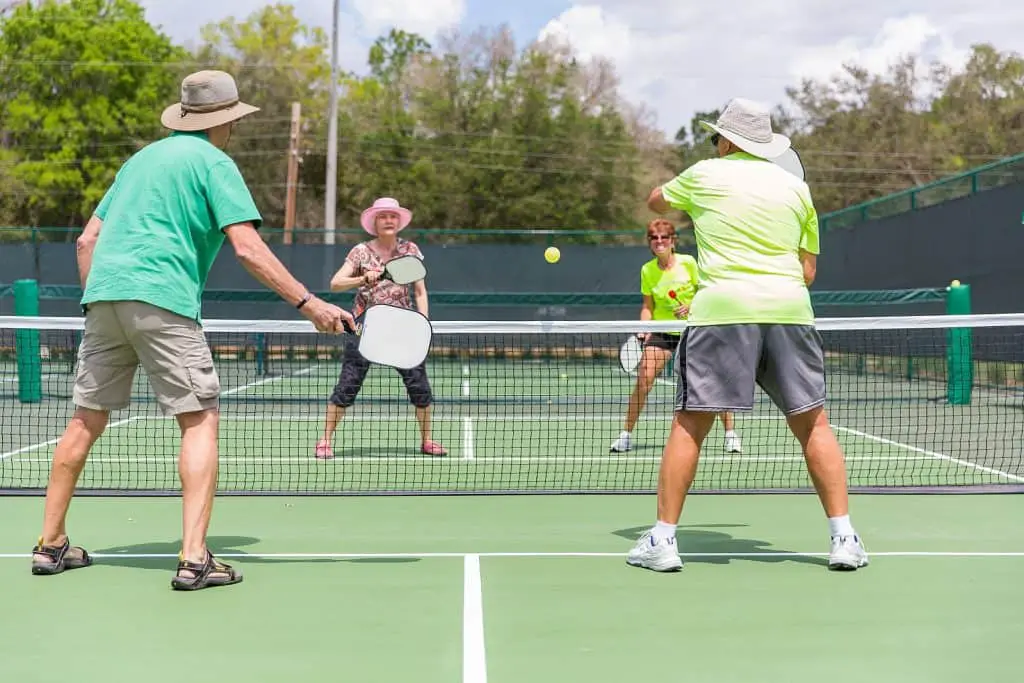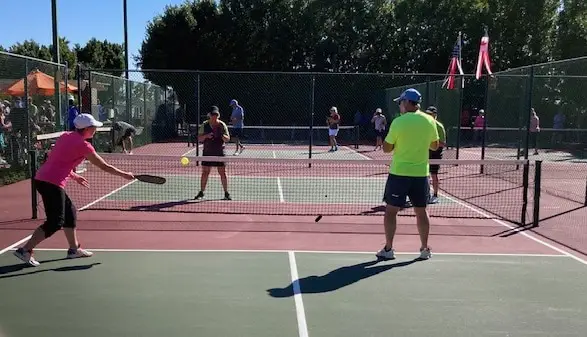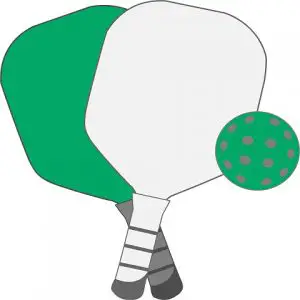Are you wondering what makes a good pickleball paddle? Or are you wondering what is the difference between Graphite and Composite? This article covers all of the different features of pickleball paddles and how to choose the best pickleball paddle for you.

Disclaimer: This post may contain affiliate links so if you make a purchase through one of the links we might earn a small commission ( it’s at no extra cost to you)
The game of pickleball hasn’t changed much, but the paddles sure have. As pickleball becomes more popular, pickleball players are starting to invest in better equipment. The wooden pickleball paddles of yore are slowly being phased out for newer, lighter, and higher performing paddles.
There are five components that make pickleball paddles different:
- Weight
- Grip size
- Shape
- Material
- Noise
A good pickleball paddle is lightweight to give you the most power and control. It’s also durable and made of quality materials that will last swing after swing.
You will want to match the pickleball paddle you choose to your play style, budget, and personal goals. Keep on reading to learn how to do just that!
Five Components of a Pickleball Paddle
There are tons of different types of pickleball paddles. Most of those differences boil down to four things: weight, grip size, paddle shape, and material. Let’s take a quick look at each.
Paddle Weight
There are lightweight paddles, mid-weight paddles, and heavy paddles. Most folks who play pickleball agree that weight is an important consideration to choose the right pickleball paddle for you.
| Lightweight paddles | Under 7.3 oz |
| Mid-weight paddles | 7.3 to 8.4 oz |
| Heavy paddles | 8.5 oz and over |
Finding a paddle with a weight that suits your playing style and physical strength is crucial. It might not seem like a big deal, but the repetitive swinging motion and physicality of the sport add up over time.
A heaver paddle might not seem too bad at the start, but after a couple of hours of playtime, depending on your fitness level, the paddle could become too heavy. Over time this could cause injury in your wrists, elbows, or shoulders.
Paddle Grip Size
There is a noticeable difference when you wear shoes that are either too big or too small for your feet. You might stumble over your own feet. Or experience pain and discomfort. The same goes for pickleball paddle grip size. Once you’ve got a preferred weight figured out, next, you will need to find the right grip size.

The paddle grip needs to match the size of your hand. When it does, it fits seamlessly within your hand, and you can maneuver the paddle with ease and no discomfort. You can estimate the ideal grip size with your height. But the best way to find the correct grip size for you is to measure your hand.
With a ruler, you can measure the distance from the tip of your ring finger to the middle crease in your palm. If that’s hard to visualize, check out this video. It’s for tennis rackets, but the system is the same for pickleball paddles.
If you are in between grip sizes, you should size down instead of up. It’s always easier to make your grip bigger and almost impossible to make it smaller. If you need to make your grip bigger, you can wrap it with extra grip tape. I have a small grip and I sized down and it was the best decision.
Paddle Shape
The official rules for pickleball paddle size state that the combined width and length of the paddle cannot be any wider than 24 inches. And that the length cannot exceed 17 inches. With that being said, paddles come in a variety of styles and combinations of width and length:
- Wide Body: wide-body paddles are considered to be the classic shape for most pickleball paddles. The classic dimensions are 8-inches wide by 16-inches long. These paddles are appropriate for most players.
- Oversized: many paddle manufacturers are making paddles with a shorter handle and longer paddle faces. Oversized paddles are good for intermediate to advanced players.
- Elongated: these paddles cut down on paddle width in order to add more paddle length. These paddles are considered to be specialty paddles for the advanced player.
Paddle Material
Every paddle consists of two parts: the exterior portion and the core. Pickleball paddles are made with a variety of materials. In general, there are three main options for both the exterior and core portions of your pickleball paddle. Each material will come with some pros and cons. Take a look at the tables to find out which is best for you:
| Paddle Exterior Materials | ||
| Wood | Composite | Graphite |
| The Heaviest weight | Variety of prices | The lightest weight |
| Cheapest | Variety of weights | Best performance |
| Good for beginners | Most expensive | |
| Good for kids | Responsive |
| Paddle Core Materials | ||
| Polymer | Aluminum | Nomex Honeycomb |
| Soft | Lightweight | Durable |
| Lightweight | Great action & control | Great action & control |
| Great control | Less power | Good for advanced players |
| The quietest core option | Quieter than Nomex, but not than polymer | Very loud |
Paddle Noise
The noise generated from a game of pickleball has been known to cause issues. We are not talking about the cheering fans and gregarious announcers, more like the thousands of popping sounds that come from when the paddle smacks the ball.
Pickleball noise is something to consider when investing in a new paddle. If you live in a gated community, retirement community, or play at a country club or recreation center, then you might need to consider restrictions on certain paddles because of the noise they make.
Paddles with a Nomex core are the loudest. And paddles with a soft polymer core are the quietest. Depending on where you play, there may be “green zone” accepted paddles and “red zone” paddles for those that are too noisy. It’s worth investigating before you make your purchase.
Price of Paddles
Pickleball paddles come on a spectrum of prices. Depending on your budget and level of play, there will be a paddle that fits your needs. And if you are nervous about investing too much, just remember that a quality paddle will last you many years, so long as you take good care of it.
Paddles can range from around $15 for the cheapest, all the way up to over $150 for the highest quality.
Top-notch graphite paddles are used by the pros, whereas more affordable composite paddles are used amongst the everyday player. If you are a complete beginner, most will tell you to avoid wooden paddles. If you play pickleball just for fun, then a middle-tier composite or graphite paddle will suit you perfectly.
“Edgeless” Pickleball Paddles
Classic pickleball paddles are designed with an edge that functions as a protective barrier. It’s not uncommon that your paddle sees some wear-and-tear, especially after a couple of years. The edge of the pickleball paddle protects the exterior and core material from being dropped or handled roughly.
Some paddle manufacturers are now making “edgeless” paddles. Essentially it’s a paddle without the plastic protective guard. Some players like this design because it increases the surface area of the face of the paddle. However, edgeless paddles will be more susceptible to dings, dents, and scuffs.
Edgeless paddles are popular amongst more advanced players. The beginner or intermediate player will still benefit from a protective edge on their paddle. Especially as they begin to learn the game and how to handle their paddle properly.
Summary
Finding the right pickleball paddle is like making sure your shoes fit correctly and are laced up properly. When it’s done right, you will notice a difference in your quality of play and how much fun you are having.
Paddle weight and grip size are the two most important considerations to get perfect.
If you have a tight budget or are buying paddles in bulk, then wood is the best option. It’s a tried and true option that will always get the job done. Wood is affordable, durable, and accessible.
If you want to step up your game, but are still only playing pickleball as a hobby, then a composite paddle is your best option. You will absolutely be able to find a paddle that fits your budget and be able to enjoy the advantages of a higher-performing material.
If you like to play pickleball competitively, then considering a graphite paddle may allow you to play at a higher level. They are the most expensive but are some of the best performing paddles money can buy.






